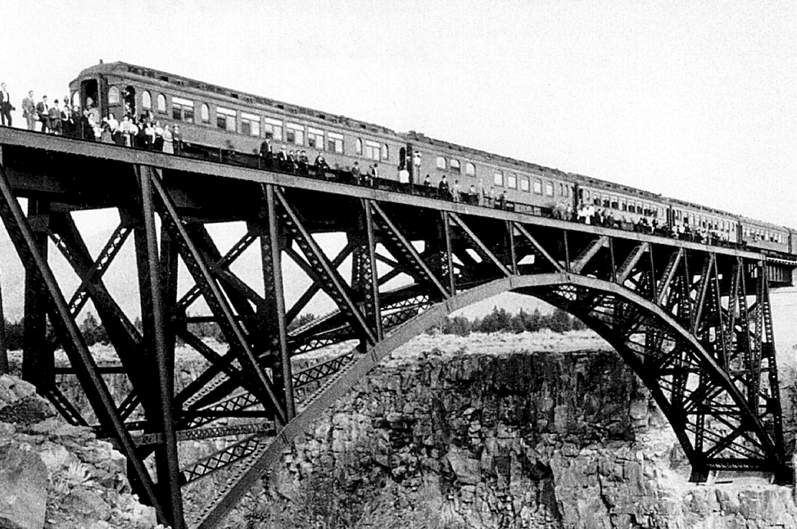Crooked River bridges documentary
Published 4:00 am Sunday, January 30, 2011

- 1911
Almost 14 years ago, the Oregon Department of Transportation started taking bids for a new bridge over the Crooked River canyon north of Redmond.
When construction started in late 1997, Chuck Hutchings was there filming. And when construction was completed and the bridge was opened to the public in September 2000, he was there again.
The construction of what is now known as the Rex T. Barber Veterans Memorial Bridge is the subject of a 30-minute documentary, “A Story of Three Bridges,” which will show on Oregon Public Broadcasting in March.
Hutchings, a Spanish instructor at Central Oregon Community College, is the man behind the camera. In the late 1990s, he enlisted the help of Ward Tonsfeldt, then an English professor at COCC and local historian who served on the bridge design committee.
Hutchings began the project while taking summer instructional technology classes at Utah State University with an eye toward using more technology in his Spanish classes. One of those classes, on videography, required a video project.
Coming from a family of contractors, Hutchings had an interest in construction and decided to make his video about the new highway bridge construction getting under way.
“I’ve seen a lot of big buildings go up,” Hutchings said. “But this project is definitely one that people talked about a lot.”
So Hutchings knew people would be interested, he said, in “things they couldn’t see when they were driving by.”
ODOT spokesman Peter Murphy said the highway bridge is a bigger project than any other in recent Oregon history.
“The old one didn’t fit the needs of the trucking industry,” he said. “The trucks are bigger and heavier and longer and faster.”
To deal with the influx of people coming into Central Oregon, the Department of Transportation decided to build the new bridge in 1997.
“It was a recognition that Central Oregon was changing, and ODOT was accommodating those changes,” Murphy said. “The nature of vehicles had changed, as had the nature of travel. … It also opened up, in the same way that almost the railroad opened up Central Oregon, the Crooked River bridge opened up this incredible land, the natural resources, the tourism industry.”
The new bridge replaced a highway bridge built by Conde McCullough in 1926, which still stands and is open to foot traffic. Also still standing is the 1911 railroad bridge that first opened up the area to travelers and business.
ODOT allowed Hutchings access to the project while it was under way and gave him grant money as well. But the filming lasted a lot longer than his summer videography class.
“It just grew legs,” Hutchings said.
When an interesting part of construction was going to take place, the ODOT engineer on site would call Hutchings, who would head over to get it on film.
He was allowed to crawl out onto areas of the bridge in the midst of construction, and ODOT even offered to send him out on a boom over the canyon. Hutchings didn’t do it, and he regrets it.
“At the time I didn’t like the shot,” he said.
Over the next few years, Hutchings shot about 50 hours of film, and Tonsfeldt co-wrote the script and provided much of the historical research. He wrapped up filming in 2001. Then, he shelved the project and focused on his work in the classroom.
In 2009, a colleague in COCC’s media department approached Hutchings about finishing up the documentary and trying to get it into the public’s eye.
It was good timing. Over the years he heard personal stories and experiences people had on the bridge, and Hutchings spent sleepless nights knowing the footage sat on the shelf.
“I realized I better get it finished,” he said.
Hutchings had always hoped the piece would get picked up by OPB, so he edited it with an eye toward their standards.
Going from 50 hours to 30 minutes wasn’t easy.
“It was difficult to throw out a lot of it,” he said. “There were things I think were interesting that maybe the regular viewer didn’t.”
Before he finalized the documentary, he showed the footage to community groups around town to get feedback, then included their favorite parts in the final cut.
The finished product covers the history of the canyon’s geology, the 1911 railroad bridge and the 1926 highway bridge, as well as the construction of the Rex T. Barber bridge.
For Hutchings, his hope is that the documentary gives people new stories to tell when they drive across the bridge.
Murphy said he’s impressed with Hutchings’ work.
“This was a labor of love,” he said. “He was simply motivated by the goodness of the project, to let people know.”
And now, Hutchings wants to continue making documentaries, this time about his area of expertise: the Spanish-speaking world.
Watch the documentary on OPB
• March 2, 6 p.m. The documentary will also be aired on ODOT’s cable television program and on COCC’s media department cable television program.






